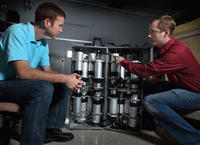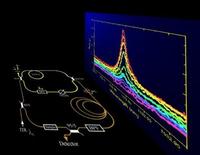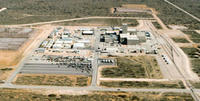-
Sandia Lab’s mobile neutron imager shines in urban emergency response exercise

A nuclear device has been hidden in a high-rise building in a major metropolitan area. Emergency responders have intelligence that narrows down the location to a single city block, but it is not safe to search door-to-door. Can they identify the exact location of the device quickly without the culprits realizing a search is on? The answer is a definite yes. Sandia Lab’ mobile imager of neutrons for emergency responders (MINER) system did just that at an emergency response exercise in downtown Chicago earlier this year. The exercise used a sealed laboratory radiation source that mimics the radioactive signature of more nefarious material.
-
-
Microrockets fueled by water neutralize chemical and biological warfare agents

With fears growing over chemical and biological weapons falling into the wrong hands, scientists are developing microrockets to fight back against these dangerous agents. Scientists point out that titanium dioxide is one of the most promising materials available for degrading chemical and biological warfare agents. It does not require harsh chemicals or result in toxic by-products. There is no way, however, actively to mix titanium dioxide in waterways, so scientists have been working on ways to propel titanium dioxide around to accelerate the decontamination process without the need for active stirring.
-
-
Light frequencies help sniff out deadly materials from a distance

Spectroscopic chemical sensing, which measures the frequency of light absorbed or scattered from a substance to help determine its molecular identity, can be used to detect traces of biological and chemical agents and residue from explosive materials. New program aims to develop chip-sized, optical frequency combs which accurately identify even tiny traces of dangerous biological and chemical substances several football fields away.
-
-
Effective, inexpensive method to detect natural gas pipeline leaks
Major leaks from oil and gas pipelines have led to home evacuations, explosions, millions of dollars in lawsuit payouts, and valuable natural resources escaping into the air, ground and water. Scientists say they have developed a new software-based method that finds leaks even when they are small, which could help prevent serious incidents — and save money for customers and industry.
-
-
U.S. planning expansion of nuclear production in the face of safety concerns

Despite the release of a damning report regarding the 14 February nuclear waste accident at the Waste Isolation Pilot Plant (WIPP) near Carlsbad, New Mexico by the U.S. Department of Energy (DOE), the government is planning ramped-up production of nuclear weapons cores, a move which is raising red flags for those calling for reform of nuclear production and storage procedures.
-
-
IAEA to provide nuclear detection technology to help diagnose Ebola in West Africa
The International Atomic Energy Agency (IAEA) said it would provide specialized diagnostic equipment to help Sierra Leone in its efforts to combat the Ebola Virus Disease (EVD) outbreak. Later, the support is planned to be extended to Liberia and Guinea. The support is in line with a UN Security Council appeal and responds to a request from Sierra Leone. The IAEA assistance will supplement the country’s ability to diagnose EVD quickly using a diagnostic technology known as Reverse Transcriptase Polymerase Chain Reaction (RT-PCR). RT-PCR is a nuclear-derived technology which allows EVD to be detected within a few hours, while other methods require growing on a cell culture for several days before a diagnosis is determined.
-
-
Transparent nanoscintillators for radiation detection in homeland security, medical safety
Researchers say recently identified radiation detection properties of a light-emitting nanostructure built in their lab could open doors for homeland security and medical advances. The researchers describe a new method to fabricate transparent nanoscintillators by heating nanoparticles composed of lanthanum, yttrium and oxygen until a transparent ceramic is formed. A scintillator refers to a material that glows in response to radiation.
-
-
Sensor network will track down illegal bomb-making
Terrorists can manufacture bombs with relative ease, few aids, and easily accessible materials such as synthetic fertilizer. Security forces do not always succeed in preventing the attacks and tracking down illegal workshops in time. Bomb manufacturing, however, leaves its traces. A network of different sensors will detect illicit production of explosives and improvised explosive devices (IEDs). Traces on doorknobs, in sewage, or in the air will be detected by the sensors and the data will be fused in a command center.
-
-
Assad retains secret caches of chemical weapons: Israeli intelligence
Despite committing to dismantle and give up its chemical weapons – Syria was in possession of the world’s largest chemical weapons stock — President Bashar al-Assad’s regime still maintains a “residual” chemical weapons capacity, consisting of a few tons of the proscribed materials. Israel’s intelligence community has concluded that the Assad regime has decided to keep this reduced, but still formidable, chemical weapons capability, and has successfully concealed it from the inspectors of the UN chemical weapons watchdog who, a few weeks ago, have declared the chemical disarmament of Syria to be officially complete. Israeli defense officials believe that these sarin gas weapons would likely be deployed if the Assad regime faced an imminent threat to its survival. The Syrian regime is continuing to use chemical weapons which were not covered by the U.S.-Russian chemical weapons disarmament agreement, especially chlorine gas.
-
-
Turning mobile phones into detectors of disease-spreading insects
Insects transmit many of the world’s most infectious diseases, but there has been a decline in the expertise needed to recognize species of insects most likely to transmit illness to people. In a new effort to safeguard human populations, a team of scientists, computer programmers, public health officials, and artists is working to enable mobile phones to link up to computers that automatically identify species of disease-carrying insects.
-
-
A second drum at nuke waste repository poses radiation leak danger

At a recent meeting of the New Mexico Legislature’s Radioactive and Hazardous Materials Committee in Carlsbad, officials were informed that a second waste drum containing nuclear materials, could also contain the same mix of ingredients as the waste drum from Los Alamos National Laboratory (LANL) which caused a radiation leak at the Waste Isolation Pilot Plant (WIPP) in February.
-
-
Deficiencies in U.S. nuclear labs’ emergency preparedness plans: Report
A recently released study of seventeen U.S. nuclear weapons laboratories by the Defense Nuclear Facilities Safety Board(DNFSB), which examined operations at the labs over the last three years, found deficiencies in emergency preparedness plans. Three New Mexico labs — the Los Alamos National Laboratory(LANL), the Waste Isolation Pilot Plant(WIPP) near Carlsbad, and Sandia National Laboratoriesin Albuquerque — exemplify various gaps in disaster preparedness throughout the nation’s nuclear defense system.
-
-
Preparing the next generation of nuclear emergency responders
The catastrophic failure of Japan’s Fukushima I Nuclear Power Plant in March 2011 was a turning point in how the scientific community viewed nuclear emergencies. Up to then, the emphasis had been on prevention, not response. Virginia Tech’s Sonja Schmid has won a 2014 National Science Foundation Faculty Early Development (CAREER) Award to study the prospects and problems of creating a global nuclear emergency response plan. Key issues to be addressed in her research are how to convince the world that any nuclear accident is everybody’s problem and how to mobilize an effective international response.
-
-
Improved gas mask protects U.S. soldiers against lethal attacks
Choking. Watering eyes. Blistering skin. Convulsions. These are all symptoms of a chemical weapons attack that can lead to imminent death. The lethality of such attacks, most recently the one in Syria in August 2013, can send tremors across the globe. For U.S. Army soldiers, however, chemical weapons present a real danger on the battlefield, and one that requires the most advanced technology to keep them safe. Scientists and researchers at the U.S. Army Edgewood Chemical Biological Center (ECBC) have been working toward better protective equipment, including the iconic gas mask.
-
-
Strengthening the armor for nuclear-waste eating microbes
A microbe developed to clean up nuclear waste and patented by a Michigan State University researcher has just been improved. Researchers had identified that Geobacter bacteria’s tiny conductive hair-like appendages, or pili, did the yeoman’s share of remediation. By increasing the strength of the pili nanowires, she improved their ability to clean up uranium and other toxic wastes.
-
More headlines
The long view
Keeping the Lights on with Nuclear Waste: Radiochemistry Transforms Nuclear Waste into Strategic Materials
How UNLV radiochemistry is pioneering the future of energy in the Southwest by salvaging strategic materials from nuclear dumps –and making it safe.
Model Predicts Long-Term Effects of Nuclear Waste on Underground Disposal Systems
The simulations matched results from an underground lab experiment in Switzerland, suggesting modeling could be used to validate the safety of nuclear disposal sites.
